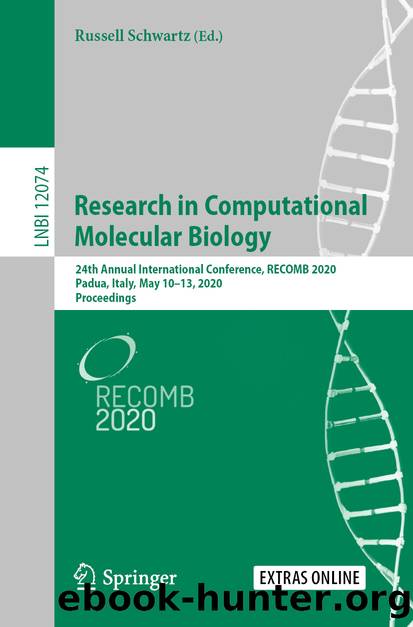Research in Computational Molecular Biology by Unknown

Author:Unknown
Language: eng
Format: epub
ISBN: 9783030452575
Publisher: Springer International Publishing
2 Results
2.1 MNase-seq Fragments of Different Lengths Are Informative About Different DNA Binding Factors
In Fig. 1a, we plot MNase-seq fragments around the transcription start sites (TSSs) of all yeast genes [16]. Fragments of length 127–187 (which we call nucleosomal fragments, or nucFrags for short) occur in tandem arrays within gene bodies but are generally absent from promoters (Fig. 1a). Fragments are particularly concentrated at the nucleosome position, just downstream of the TSS, because the nucleosome is usually well-positioned. Furthermore, the marginal density of the midpoints of these fragments around annotated nucleosome dyads [2] peaks precisely at the dyad, with counts dropping nearly symmetrically in either direction (Fig. 1b). This makes sense because MNase digests linker regions, leaving behind undigested DNA fragments wrapped around histone octamers. So the midpoint counts of these nucFrags would be highest at the annotated dyads and decrease on moving away from the dyad.
In addition, it has been shown that shorter fragments in MNase-seq provide information about TF binding sites [10]. To verify that we see this signal in our data, Fig. 1a reveals that promoter regions are enriched with shorter fragments. The promoter region is often bound by specific and general TFs that aid in the transcription of genes. To ensure that the MNase-seq signal in these promoter regions is not just noise, we plot the MNase-seq midpoints around annotated TF binding sites. We choose the well-studied TF, Abf1, because it has multiple annotated binding sites across the genome. On plotting the MNase-seq midpoint counts around these annotated binding sites we notice a clear enrichment of short fragments at the binding sites (Fig. 1c). We denote these short fragments of length less than 80 as shortFrags. Unlike the midpoint counts of the nucFrags which have a symmetrically decreasing shape around the nucleosome dyads, the midpoint counts of shortFrags are more uniformly distributed within the binding site (Fig. 1c). The shortFrags signal at the Abf1 binding sites is noisier than the MNase signal associated with nucleosomes. One reason for this increased noise is that fragments protected from digestion by bound TFs may be quite small, and the smallest fragments (of length less than 27 in our case) are not even present in the dataset due to sequencing and alignment limitations.
We ignore fragments of intermediate length (81–126) in our analysis, though these could provide information about other kinds of complexes along the genome, like hexasomes [18]. Such factors would also be important for a complete understanding of the chromatin landscape, but we limit our analysis here to studying the occupancy of nucleosomes and TFs. For the subsequent sections of this paper, we only consider the midpoint counts of nucFrags and shortFrags. A representative snapshot of MNase-seq fragments is shown in Fig. 2a. We further simplify the two-dimensional plot in Fig. 2a to form two one-dimensional signals by separately aggregating the midpoint counts of nucFrags and shortFrags, as shown in Fig. 2b.
Fig. 2.(a) MNase-seq fragment midpoints in region chrI:61000–63500 of the yeast genome. Each dot at position (x, y)
Download
This site does not store any files on its server. We only index and link to content provided by other sites. Please contact the content providers to delete copyright contents if any and email us, we'll remove relevant links or contents immediately.
Algorithms of the Intelligent Web by Haralambos Marmanis;Dmitry Babenko(9832)
Test-Driven Development with Java by Alan Mellor(7658)
Data Augmentation with Python by Duc Haba(7543)
Principles of Data Fabric by Sonia Mezzetta(7318)
Learn Blender Simulations the Right Way by Stephen Pearson(7233)
Microservices with Spring Boot 3 and Spring Cloud by Magnus Larsson(7070)
RPA Solution Architect's Handbook by Sachin Sahgal(6459)
Jquery UI in Action : Master the concepts Of Jquery UI: A Step By Step Approach by ANMOL GOYAL(6447)
The Infinite Retina by Robert Scoble Irena Cronin(6170)
Hadoop in Practice by Alex Holmes(6138)
Big Data Analysis with Python by Ivan Marin(5884)
Life 3.0: Being Human in the Age of Artificial Intelligence by Tegmark Max(5474)
Pretrain Vision and Large Language Models in Python by Emily Webber(4842)
Infrastructure as Code for Beginners by Russ McKendrick(4623)
WordPress Plugin Development Cookbook by Yannick Lefebvre(4342)
Functional Programming in JavaScript by Mantyla Dan(4216)
The Age of Surveillance Capitalism by Shoshana Zuboff(4209)
Embracing Microservices Design by Ovais Mehboob Ahmed Khan Nabil Siddiqui and Timothy Oleson(4114)
Applied Machine Learning for Healthcare and Life Sciences Using AWS by Ujjwal Ratan(4092)
